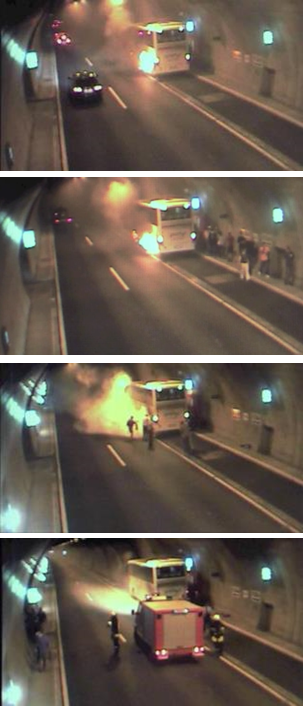
Road Tunnels Manual

Road Tunnels Manual
Among the possible risks to be considered in road tunnels, vehicle fires give rise to particular concern because they are not very rare events and their consequences may be far larger underground than in the open if no appropriate measures are taken.
The discussion on tunnel fires is often dominated by the extreme events which occurred in the Mont Blanc tunnel, the Tauern tunnel and the Gotthard Tunnel. However, in reality the majority of tunnel fires are relatively small events in comparison, which nevertheless may have the potential to develop into more serious events, depending on various influencing factors. The confined space of a tunnel provides an environment in which untenable conditions may develop rapidly in case of a fire. Series of real fire tests have been performed in the context of various national and international research programs in order to confirm assumptions on fire sizes and fire behaviour; in these tests the focus again was on large scale fires with high heat release rates.

There are a few key parameters for the characterisation of a tunnel fire: The speed of fire development and the fire size are of significant importance with regard to tunnel safety. Both are influenced by the nature of the fire load, the technical conditions of the vehicles involved, the airflow conditions in the tunnel during fire development as well as the fire safety engineering design of the specific tunnel. The maximum heat release rate of a fire depends on the quantity and type of material of the fire load as well as the boundary conditions of oxygen supply, tunnel characteristics and system response etc.. Fires in personal vehicles rarely develop to high heat release rates, whereas fully developed fires in the cargo of heavy goods vehicles and pool fires of burnable liquids potentially can develop into very high heat release rates.
Two types of tunnel fires (triggered by a collision or a vehicle defect) can be distinguished with regards to their characteristics: fires resulting from vehicle defect typically start in engine, exhaust system, wheels or brakes; seldom in the load. These fires in most cases are shielded fires which are likely to develop slowly in the first phase, with progressive development in later phase resulting in a fully developed fire. This type of fire development increases the opportunity to extinguish a fire (or delay its further development) either by the use of manual fire extinguishers, fixed fire fighting systems and/or by responding fire fighters, before it is able to threaten the health and safety of people in the tunnel. Fires after collisions are often accelerated by (limited amounts) of fuel that has leaked as a result of the collision, hence the development is typically faster. Flammable liquid fires, i.e. pool fires with large amounts of flammable liquids, are extremely rare occurrences, which require a large amount of flammable liquid to be released (as a consequence of a collision or by other reasons).
In Chapter 4 of the technical report 2016 R35 « Experience with significant incidents in road tunnels » new information on fires rates has been compiled, based on tunnel fire statistics from 12 countries around the world. The collection of data for statistical purposes requires a clear definition of events which should be considered as fires. Today there is different practise in different countries on what event is recorded as a fire and what is not; in the context of this report the defintion of the term « fire » according to the Norwegian Directorate for Civil Protection has been applied: a fire is“an unwanted or uncontrolled combustion process characterised by heat release and accompanied by smoke, flames or glowing”.
It seems that an “average tunnel” has a fire rate in the order of magnitude 5 – 15 fires per billion vehicle km. However, the scatter of the rates from tunnel to tunnel may be very significant as a number of factors may influence the recorded fire rates, for instance: tunnel design, location of the tunnel, geometry of the road, monitoring, technical standard of the vehicles, traffic regulation, speed limits, driving culture etc., hence the fire rates should be used with care and the assessment of the applicability and the modification of the basic rates required for an application for a given tunnel should be done by experts with experience in tunnel safety.
To get statistical information on type and severity of fire events is an even more complex issue. Therefore expert opinion is required in addition to the knowledge and information available from real fire incidents and real sclae fire tests. Based on recordings from Austria, Italy and South Korea, some indications are presented in Chapter 4.6 of the report 2016 R35« Experience with significant incidents in road tunnels ».
An understanding of how smoke behaves during a tunnel fire is essential for every aspect of tunnel design and operation. This understanding will influence the type and sizing of the ventilation system to be installed, its operation in an emergency and the response procedures that will be developed to allow operators and emergency services to safely manage the incident. Detailed discussion on the topic can be found in Section III "Smoke behaviour" and Section 1 "Basic principles of smoke and heat progress at the beginning of a fire", which analyse in detail the influence of different parameters (traffic, fire size, ventilation conditions, tunnel geometry) in the development of an incident.
Some randomly selected examples of real tunnel fires (including a short discription and analysis of the event) can be found in Appendix 5 of the technical report 2016 R35 “Experience with Significant Incidents in Road tunnels"